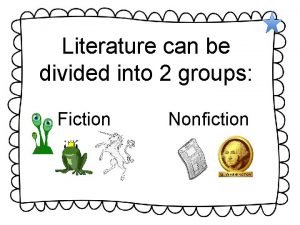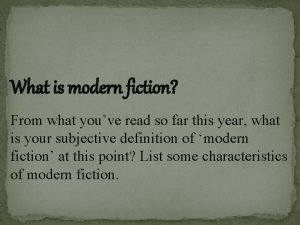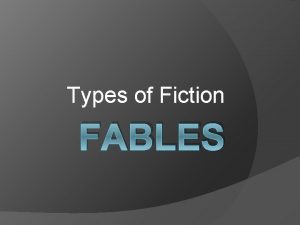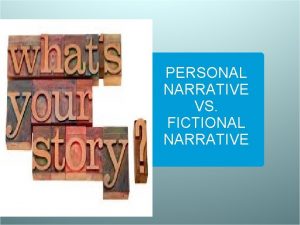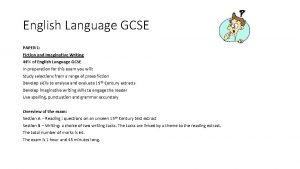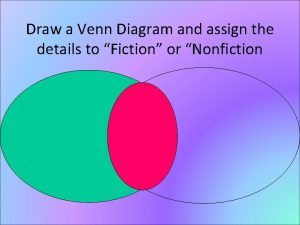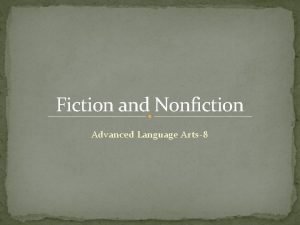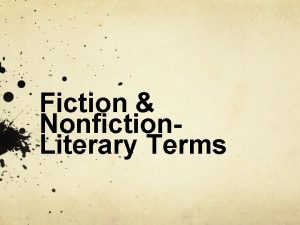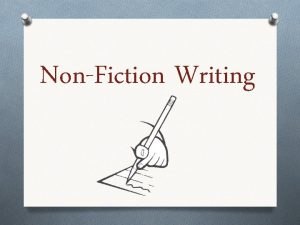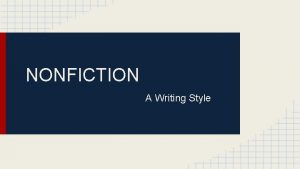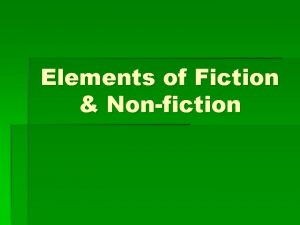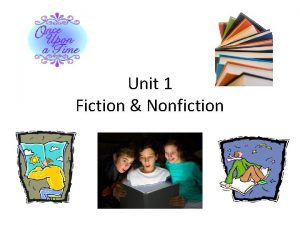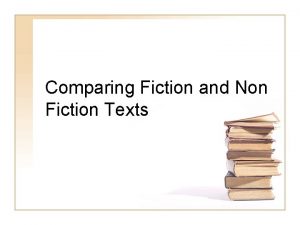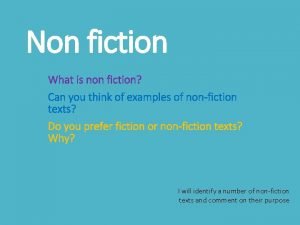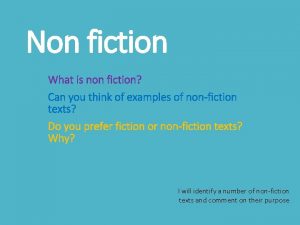Creative NonFiction Creative Non Fiction Creative nonfiction is











- Slides: 11

Creative Non-Fiction {

Creative Non Fiction Creative non-fiction is a relatively recently recognized “genre” that involves writing from personal experience and/or reporting on other peoples’ experiences. The best creative nonfiction work usually involves conducting a considerable amount of research, most often “in the field, ” involving oral history interviewing, participant observation, detective/sleuthing work, as well as jumping into new adventures. The range of possible topics is virtually unlimited, and this type of writing actually has a very long history. Creative nonfiction encompasses memoir writing, biography and autobiography, oral history, and inspired reportage on almost any subject. It involves writing about actual events in your own life and/or others’ lives, conveying your message through the use of literary techniques such as characterization, plot, setting, dialogue, narrative and personal reflection Take two sheets of paper and fold then tear in half so you have 4 equal pieces What is Creative Non. Fiction

Describe a smell from your past. Don't worry whether or not it is a significant or important smell; all that matters is that it remains in your "memory bank" 10 or 20 or 30 years later. Describe the smell, the quality of the odor. Is it sour or sweet, smoky or clean, sharp or dull? Does it remind you of anything? Keep this to around four or five sentences. The Experimental Mini Essay The First Card

Describe part of someone you love, but just a part. Stick to one physical aspect—your mother's hair, your Aunt Lula's elbows, your little brother's teeth. Be specific. Instead of "dad had rough hands, " describe the texture of the palms, the shape of the fingers, the bruises or cuts, the caked oil in the seams. No more than six sentences. The Second Card

Pick a snippet of conversation from your past, something you heard all of the time when you were younger. It can be significant—a parent's correction or sharp criticism—or seemingly insignificant—a dumb joke your older brother made every time you sat down to eat chili. It can be anything at all. The only requirement is that you heard it and that it remains in your memory bank, for whatever reason. Do NOT illuminate, describe, or elucidate. Just give us the quote: "Drink your milk. You want to have strong bones, don't you? " "I don't like milk. " "Don't come crying to me when you're old and rickety. " On the Third Card

Construct a disjointed list of 30 words, primarily nouns, or nouns with some slight modification. Each of these words or phrases describes a remembered something in your past. For instance, my list looks like this: "Ringo. Sled. Uncle Clem's wooden leg. Cooked cabbage. Howdy Doody. Bugs. Sycamore tree. " In this instance, it is not important to give enough information for the reader to fully understand. Just make your list. No phrase more than four words long. Thirty words. (It often works best to write 45 words, and then cross some out. ) On the Fourth Card

Next When you have completed the five steps above, take the four cards and shuffle them in random order. At the top of each card, write a number 1 through 4. To the first card, add this title: "Why I Am Who I Am. "

It is standard procedure for high school students to spend time thinking about how to write a “personal statement” which is a kind of creative non-fiction (yesterday’s assignment should have gotten you thinking along these lines). We are often asked to write essays such as this for a variety of reasons and it is more and more common to see these kinds of questions appear outside the world of college. When you write a resume some day, a personal statement can help you formulate an introduction letter. From the UC Appication Website: Your personal statement should be exactly that — personal. This is your opportunity to tell us about yourself — your hopes, ambitions, life experiences, inspirations. We encourage you to take your time on this assignment. Be open. Be reflective. Find your individual voice and express it honestly. As you respond to the essay prompts, think about the admissions and scholarship officers who will read your statement and what you want them to understand about you. While your personal statement is only one of many factors we consider when making our admission decision, it helps provide context for the rest of your application. Responses to your two prompts must be a maximum of 1, 000 words total. Allocate the word count as you wish. If you choose to respond to one prompt at greater length, we suggest your shorter answer be no less than 250 words. UC writing Prompts

Describe the world you come from — for example, your family, community or school — and tell us how your world has shaped your dreams and aspirations. Notebook page 14 -15 Writing Prompt #1

Tell us about a personal quality, talent, accomplishment, contribution or experience that is important to you. What about this quality or accomplishment makes you proud and how does it relate to the person you are? Notebook page 16 -17 UC Writing Prompt #2

Return to the four sections you originally wrote. Begin by revising for “word choice”. Since space is limited, each word needs to be precise and interesting. Decide how you will lay out the four sections How will the reader “read” you piece? How do you want them to read it? Should be typed. Keep it simple and play around with placement, alignment and font. No extra embellishments. Let the words do the work for you. The Experimental Essay Final
 What is fiction and nonfiction
What is fiction and nonfiction Realistic fiction
Realistic fiction Speculative fiction characteristics
Speculative fiction characteristics Contemporary realistic fiction vs historical fiction
Contemporary realistic fiction vs historical fiction What is modern fiction
What is modern fiction Types of fables
Types of fables Fictional narrative
Fictional narrative English language paper 1 fiction and imaginative writing
English language paper 1 fiction and imaginative writing Fiction and nonfiction venn diagram
Fiction and nonfiction venn diagram 7 elements of nonfiction
7 elements of nonfiction Elements of fiction and nonfiction
Elements of fiction and nonfiction Debout jeunesse lève toi
Debout jeunesse lève toi

